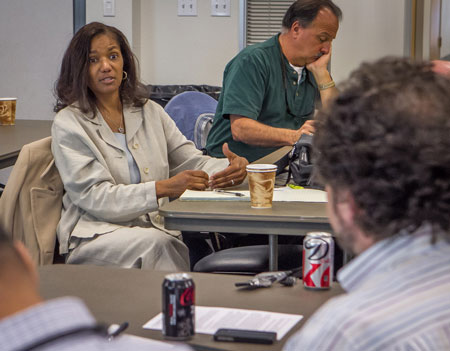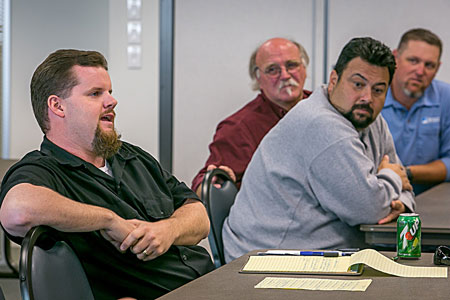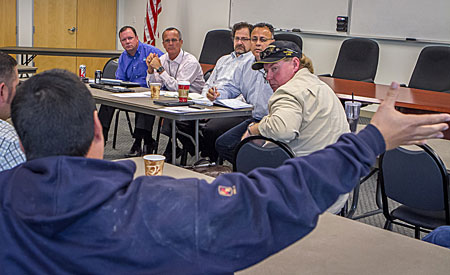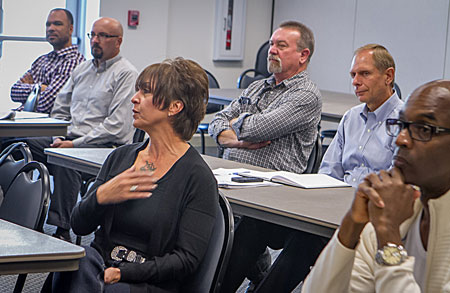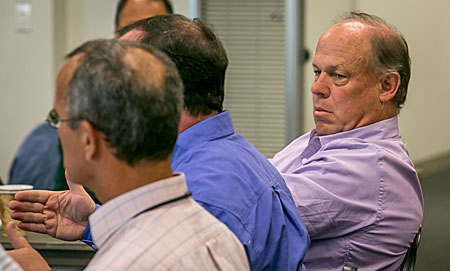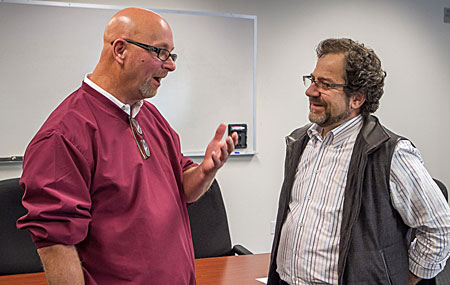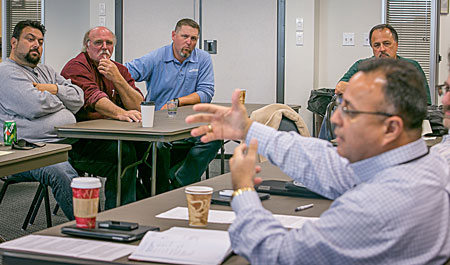Nick Stavropoulos discusses gas safety and staffing with IBEW members
PG&E has made big strides in improving the safety of its natural gas system, but potentially steep fines stemming from the 2010 San Bruno explosion could jeopardize future progress.That was the sobering assessment offered to IBEW 1245 members at Weakley Hall by Nick Stavropoulos, Executive Vice President for Gas Operations. The Nov. 18 meeting with over two dozen IBEW members and staff was the latest of several that he has held to hear the views of people working in the field.“The first time I came here,” Stavropoulos said, “it was fabulous. You laid out for me all the problems we were having. And I tell people, about 80% of the stuff we had to do and fix came out of that very first meeting that we had.”He cited several areas in which progress has been made in the company’s natural gas system. He noted that in just two years the company had moved from the bottom quartile to the top quartile in its emergency response. The company has also reduced the backlog of Grade 2 leaks in the distribution system from 8,000 to about 500 in just 24 months, replaced 80 miles of transmission pipe, and verified the safety of 580 miles of pipe through hydro-testing or locating “traceable, verifiable records.”One problem the utility faces, he noted, is that less than a third of its gas transmission system can be inspected by in-line tools, a process commonly referred to as “pigging.” That percentage is low by industry standards.“Our goal is to make a significant portion of our line ‘piggable,’” he said.But the problems with PG&E’s natural gas system have accumulated over a period of 30 years, he said. “I can’t fix it overnight.”Board Supportive
Gas Crew Lead Welder and Advisory Council member Steve Segale asked if there had been pressure from within the company to cut back on the repair program in gas. Stavropoulos said there had been no cutback “in what we think we want to do.”Stavropoulos said the company’s request for funds for gas work in the upcoming General Rate Case at the CPUC was “huge” compared to what the company had been spending annually three years ago, and “pretty much in line” with the increased spending levels of the past two years.“To date the Board has been very supportive,” said Jesus Soto, a Senior Vice President in Gas Operations who accompanied Stavropoulos to the Weakley Hall meeting. “So far there’s been lots of internal support and the mission remains the same.”That mission, however, could be jeopardized by CPUC proceedings now underway to determine the size of the fine PG&E will face in connection with the San Bruno explosion in 2010 that killed 8 people and destroyed 38 homes.Stavropoulos said PG&E already had $2.4 billion in shareholder money “on the table,” with the possibility that some of that could be offset by past and future company investments in upgrading the system. But some regulators have suggested levying penalties of up to $4.4 billion.IBEW 1245 Business Manager Tom Dalzell warned in a Monterey Herald op-ed piece in September that penalties of this magnitude would “set back badly needed job-creating investments” and delay or even derail steps needed “to modernize our energy system.”Under Stavropoulos, the company has ramped up hiring in a dramatic fashion, a necessary step long advocated by the union. In the past two years, 400 IBEW-represented employees have been added to the gas department. But it’s difficult to see how this effort could be sustained if the CPUC ultimately adopts a $4 billion penalty.“We’re not the government so we don’t print money,” said Stavropoulos. “We don’t have $4 billion cash in the bank.”A tentative decision by the CPUC staff is expected in January, with a final decision by the CPUC commissioners coming toward the end of the first quarter of 2014.
Training Concerns
In a give and take that last some three hours, IBEW members weighed in on several issues. Training was a big concern.“On the Clerical side, we have no training,” said Adrianne Frank, a Senior Operating Clerk 1 and 34-year IBEW member. Supervisors, she said, are “trying to get information for us, but the people who are trying to train them are not knowledgeable about everything we do on the Clerical side.”“There’s nothing that could be more supportive to the whole group—and certainly making the supervisor’s life easier—than a well-trained clerk,” Segale chimed in.Gas Crew Foreman Jack South said that Clerical members drive a lot of the work at PG&E. The company may have one person trained, he said, but there’s “no backup” if the clerk is on vacation. In some cases people are bidding into local yards without the necessary background in the work.It’s not their fault,” said South. “They need a good training program.”Stavropoulos noted steps the company was taking to improve workforce training. One problem the company faces, though, is “churn.”“Only 25% of welders hired 4 years ago are still welders today,” he said. “It costs a lot to train them, so keeping them in place is important.”That prompted a response from David Stout, a gas crew lead welder: “My generation gets bored. They don’t like being stuck in the same constant job.”Stavropoulos acknowledged the importance of allowing people to develop in the company. He suggested one way to reduce churn was for the company to do a better job of assessing people coming in to make sure they were getting properly matched to “the type of work they want to do.”PG&E executives leading the meeting, in addition to Stravropoulus and Sota, were John Higgins, Senior Director Field Operations, Kevin Knapp, Vice President Gas T&D Operations, and Industrial Relations Director Steve Rayburn and members of his staff.

